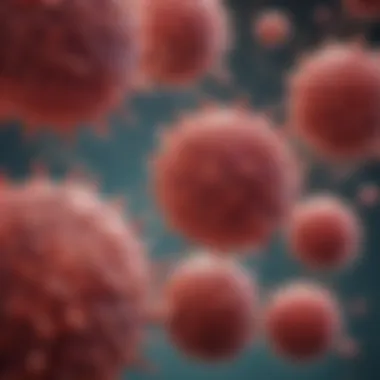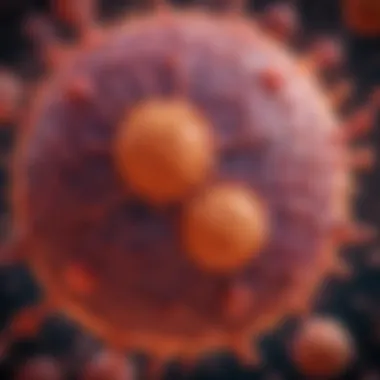Understanding AML Cells: Key Characteristics and Functions


Intro
Acute Myeloid Leukemia (AML) poses significant challenges in the realm of hematology. It is crucial to glean a deeper understanding of AML cells to navigate the complexities of this disorder effectively. This section aims to set the foundation for a comprehensive exploration into the characteristics, functions, and implications of AML cells.
As an advanced yet heterogeneous group of myeloid malignancies, AML is marked by the overproduction of myeloid precursor cells. These cells differ structurally and functionally from healthy hematopoietic cells, leading to a myriad of clinical manifestations. Delving into the attributes of AML cells unveils their intricate relationship with the surrounding microenvironment and the therapeutic avenues available to combat this disease.
The subsequent sections will illuminate essential concepts, pertinent research trends, and implications for treatment strategies, ensuring readers can navigate the evolving landscape of AML with clarity and precision.
Prolusion to AML Cells
Acute Myeloid Leukemia (AML) is a crucial topic within hematology due to its complexity and impact on patient health. Understanding AML cells lays the foundation for both scientific inquiry and clinical practice. The characteristics of these cells are not only vital for diagnosis but also for the development of targeted therapies. This section aims to establish a contextual framework that elucidates the fundamental aspects of AML cells, serving as a guide for deeper exploration in the following sections.
Defining Acute Myeloid Leukemia
Acute Myeloid Leukemia is a type of cancer that initiates from the myeloid line of blood cells. It is characterized by the rapid proliferation of abnormal myeloid cells in the bone marrow and bloodstream. These cells do not mature properly, leading to a decrease in healthy blood cells. As a result, patients may experience symptoms like fatigue, frequent infections, and bruising. The World Health Organization categorizes AML based on specific genetics and morphology, highlighting the disease's heterogeneity. These classifications play a significant role in determining prognosis and treatment options.
Historical Context of AML Research
Research on Acute Myeloid Leukemia has evolved considerably over the decades. Initial studies haphazardly identified AML as a distinct entity in the 1920s, but understanding its underlying mechanisms took much longer. Major advancements in genetics and molecular biology during the late 20th century have provided deeper insights into AML's pathogenesis. For instance, the discovery of specific genetic mutations like the FLT3 and NPM1 has led to targeted therapies that vastly improve patient outcomes. Such historical knowledge underscores the importance of ongoing research to refine treatment modalities and clinical approaches.
Biological Characteristics of AML Cells
Understanding the biological characteristics of Acute Myeloid Leukemia (AML) cells is crucial to comprehending the disorder's complexity. These characteristics define how AML cells behave, how they interact with their environment, and how they respond to treatments. Knowledge in this area helps in tailoring therapeutic approaches suitable for individual patients, which is essential for effective management of the disease.
Cellular Morphology
The morphology of AML cells can provide immediate insights into their biological nature. Typically, these cells exhibit abnormal size, shape, and organization when examined under a microscope. Morphological features might include an increased nucleus-to-cytoplasm ratio, irregular nuclear contours, and prominent nucleoli.
Different subtypes of AML may present varying cellular characteristics. For instance, cells in acute promyelocytic leukemia (APL) can show distinct features such as bundles of cytoplasmic granules known as "faggot cells." These morphological differences are important not just for diagnosis but also for understanding the biology of the different AML subtypes.
Genomic Alterations
Genomic alterations play a significant role in the pathogenesis of AML. They encompass various structural and numerical changes in chromosomes, which can drive leukemogenesis. Understanding these alterations is vital for developing targeted therapies and improving patient outcomes.
Mutation Profiles
Mutation profiles provide a detailed landscape of the genetic changes in AML cells. They include mutations in critical genes such as FLT3, NPM1, and TP53. These mutations can influence disease progression and treatment response. The identification of specific mutations in AML is beneficial for personalized medicine approaches. In essence, certain profiles allow clinicians to predict which treatment options might be most effective for a patient.
The advantages of understanding mutation profiles lie in their ability to stratify patients based on risk, enabling targeted therapy. However, not all mutations can be detected or understood fully, which can limit therapeutic options for some patients.


Chromosomal Abnormalities
Chromosomal abnormalities also constitute a significant area of research in AML. Some common abnormalities include translocations, deletions, and trisomies. These alterations can lead to the creation of fusion genes, which may express proteins that drive tumor growth.
For instance, the bcr-abl fusion gene in chronic myeloid leukemia is well-studied, but similar fusions can influence AML pathology as well. Understanding these chromosomal changes is essential as they can sometimes convey specific prognosis and influence treatment decisions.
The unique features of chromosomal abnormalities can help in distinguishing different AML subtypes, which in turn, can dictate the choice of treatment. However, the complexity and variety of abnormalities present a challenge in the clinical setting since some may not have clear treatment pathways associated with them.
Cellular Phylogeny
Cellular phylogeny refers to the evolutionary relationships between different cell types within the hematopoietic system. In AML, understanding this phylogeny aids in identifying the cell of origin and the differentiation block that leads to malignancy. By mapping these relationships, researchers can gain insights into how AML cells deviate from normal hematopoietic progenitors. The study of phylogeny can contribute to the identification of critical drivers of AML, offering potential targets for new therapies.
Pathophysiology of AML
The pathophysiology of Acute Myeloid Leukemia (AML) is essential for a comprehensive understanding of this complex disease. It focuses on the underlying mechanisms that lead to the development and progression of AML. Understanding these mechanisms helps in identifying critical therapeutic targets. This section elaborates on two fundamental aspects: the mechanisms of leukemogenesis and the role of the bone marrow microenvironment.
Mechanisms of Leukemogenesis
Leukemogenesis refers to the process by which normal hematopoietic cells undergo malignant transformation. This transition is not a singular event but, rather, involves a series of alterations. Mutations in genes that regulate cell growth and division play a significant role in this process, leading to the uncontrolled proliferation of myeloid progenitor cells.
Several key mutations are noted in AML such as those in the FLT3, NPM1, and ID genes. These mutations contribute to various signaling pathways, leading to cell survival and growth advantages. A detailed understanding of these genetic alterations is crucial as they not only assist in diagnosing AML but also in formulating targeted therapies. The identification of mutation profiles can indicate prognostic outcomes, thus informing treatment decisions.
Role of the Bone Marrow Microenvironment
The bone marrow microenvironment plays a pivotal role in the pathophysiology of AML. It consists of various cellular components and extracellular matrix that support the growth and survival of malignant cells. The interaction between AML cells and the surrounding microenvironment influences disease progression and response to treatment.
Cell-Cell Interactions
Cell-cell interactions within the bone marrow microenvironment are critical. AML cells communicate with stromal cells, such as mesenchymal stem cells and endothelial cells. These interactions can promote survival signals and increase resistance to conventional therapies. A notable characteristic of these interactions is their ability to create a protective niche for AML cells. This niche not only supports cell viability but also shields them from therapeutic agents. The key benefit of studying these interactions lies in the potential to design strategies that disrupt these signaling pathways, aiming to enhance the efficacy of existing treatments.
"Understanding cell-cell interactions in the bone marrow is crucial for developing targeted therapies against AML."
"Understanding cell-cell interactions in the bone marrow is crucial for developing targeted therapies against AML."
Extracellular Matrix Components
The extracellular matrix (ECM) presents another crucial aspect of the bone marrow microenvironment. It consists of proteins and glycoproteins that provide structural support to tissues. In AML, the composition of the ECM can alter, facilitating the adhesion of AML cells. This adhesion contributes to their proliferation and protection from apoptosis. A significant feature of the ECM in AML is its increased rigidity. A rigid ECM can enhance cell signaling pathways that promote cellular growth and survival. While this characteristic can offer insights for therapeutic interventions, it can also present challenges, as targeting ECM components may risk damaging normal hematopoietic function.
Clinical Manifestations of AML
The clinical manifestations of Acute Myeloid Leukemia (AML) are crucial for understanding the impact of this disease on patients. These manifestations often provide the initial signals prompting further investigation and diagnosis. Characterizing symptoms can lead to early detection, which significantly influences treatment outcomes. Knowledge of these manifestations benefits healthcare providers in making informed clinical decisions and facilitates better patient management. Understanding the clinical features allows for tailored therapeutic strategies that address both the disease and its complications.


Common Symptoms
Common symptoms of AML can vary widely among patients. The most frequent include:
- Fatigue: A persistent feeling of exhaustion stemming from anemia due to bone marrow failure.
- Pallor: A pale appearance resulting from decreased red blood cell production.
- Fevers: Often due to infections related to neutropenia, which is a reduction in white blood cells.
- Unexplained bruising or bleeding: This happens because of low platelet counts.
- Bone pain: Patients may experience discomfort as leukemic cells infiltrate the bone marrow.
These symptoms typically stem from the disease's effects on various blood cell lines. Though they may seem general, they are critical indicators. This combination of symptoms can help differentiate AML from other hematologic conditions, leading to timely intervention.
Diagnosis and Staging
Diagnosis and staging are pivotal in the management of AML. Both processes help in determining the progression and severity of the disease. Accurate diagnosis allows for appropriate therapy selection while staging helps in predicting prognosis and treatment outcomes.
Diagnostic Criteria
The diagnostic criteria for AML primarily rely on specific blood tests and bone marrow examination. A defining characteristic is the presence of at least 20% blasts in the bone marrow or peripheral blood. This criterion is widely accepted in clinical practice due to its reliability. The main advantage of this approach is its capacity to quickly classify AML, directing therapies early on.
However, potential disadvantages exist. The bone marrow biopsy, while essential, is an invasive procedure that may not always be acceptable to some patients. In addition, variations in individual presentation can sometimes lead to misdiagnosis or delays in treatment. Despite these limitations, the efficiency of the diagnostic criteria in establishing the presence of AML cannot be overstated.
Staging Systems
Staging systems for AML, such as the French-American-British (FAB) classification or the World Health Organization (WHO) criteria, are important in assessing disease progression. They categorize AML based on various factors including cytogenetics and morphologic features. A key advantage of these systems is their ability to stratify patients into risk groups, influencing treatment decisions.
On the downside, the complexity of staging can sometimes lead to confusion among providers and patients alike. Additionally, certain systems may not account for all genetic anomalies present in AML, which can limit their applicability in personalized medicine approaches. Nevertheless, effective staging remains a cornerstone of AML management, guiding therapeutic strategies while informing patients about their prognosis.
Therapeutic Approaches in AML Management
Acute Myeloid Leukemia (AML) presents a complex challenge in hematology due to its aggressive nature and variable genetic landscape. Effective management of AML requires an understanding of various therapeutic approaches. These methods not only target the disease itself but also aim to improve patient outcomes and quality of life. This section examines the primary treatment modalities utilized in the management of AML, namely chemotherapeutic agents, targeted therapies, and stem cell transplantation. Each of these approaches has distinct characteristics and implications that are critical to developing a comprehensive treatment strategy.
Chemotherapeutic Agents
Chemotherapy remains the cornerstone of AML treatment. These agents primarily aim to eliminate leukemic cells and restore normal hematopoiesis. Typically, the regimens used consist of a combination of drugs that target rapidly dividing cells. Cytarabine and anthracyclines are among the most commonly used chemotherapeutic agents. They work by interfering with the DNA synthesis or function within the cells, leading to cell death.
While effective, the use of these agents can result in significant side effects. Myelosuppression, an unintended suppression of bone marrow activity, often occurs leading to increased risk of infection, anemia, and bleeding. Hence, careful monitoring is essential during treatment. Moreover, the heterogeneity of AML makes it crucial to tailor chemotherapy based on individual patient profiles.
Targeted Therapies
Targeted therapies have emerged as promising adjuncts or alternatives to conventional chemotherapy. They are designed to specifically target genetic mutations or specific markers present on cancer cells, minimizing damage to normal cells.
Monoclonal Antibodies


Monoclonal antibodies are an important class of targeted therapies. One key characteristic is their ability to selectively bind to specific antigens on the surface of leukemic cells. For example, Gemtuzumab ozogamicin, a monoclonal antibody conjugated with a cytotoxic agent, targets the CD33 antigen found in many AML cells. The selective binding helps deliver the cytotoxic agent directly to the cancer cells, enhancing efficacy while reducing systemic side effects.
However, monoclonal antibodies also have limitations. They may not work for all patients due to variations in antigen expression. Further, the need for careful patient selection and monitoring of response is crucial to achieve optimal outcomes.
Small Molecule Inhibitors
Small molecule inhibitors represent another innovative approach in AML management. These drugs target specific pathways that are aberrant in leukemic cells. Midostaurin, for instance, inhibits the FLT3 receptor tyrosine kinase, commonly mutated in AML. This key characteristic allows it to effectively reduce the proliferation of leukemic cells.
Small molecule inhibitors offer flexibility in administration and can be combined with other therapies to enhance treatment efficacy. Nonetheless, resistance can develop over time, presenting a significant challenge. Therefore, ongoing research to identify additional targets and develop newer inhibitors continues to be critically important.
Stem Cell Transplantation
Stem cell transplantation offers potentially curative treatment, especially for patients with high-risk or refractory AML. This approach involves the replacement of diseased bone marrow with healthy stem cells. Both autologous and allogeneic stem cell transplantation are utilized, depending on the patient's condition and eligibility.
The main advantage of stem cell transplantation is its ability to eradicate residual leukemia via the graft versus leukemia effect. However, it comes with challenges including graft-versus-host disease and the meticulous need for donor matching. The decision to proceed with stem cell transplantation should consider the patient’s age, general health, and risk factors associated with AML.
Research into improving transplantation techniques and post-transplant care continues to evolve. These developments may further enhance the efficacy and safety of this significant therapeutic approach.
Research and Future Directions
Research and Future Directions play a crucial role in understanding Acute Myeloid Leukemia (AML). The complexity and heterogeneity of AML cells necessitate ongoing exploration to improve patient outcomes. As our knowledge expands, innovative strategies emerge, aiming to enhance diagnostic accuracy, treatment efficacy, and overall patient care.
Emerging Biomarkers
Emerging biomarkers are essential for early detection and tailored therapies in AML. Biomarkers can indicate disease presence and progression, helping to refine treatment plans. Some leukemia-specific mutations, such as NPM1 and FLT3, have gained attention. They contribute to prognosis and assist in guiding therapy choices. Researchers also investigate novel circulating tumor DNA and RNA profiles. These markers may serve as both diagnostic tools and indicators for response to treatment. Their integration into clinical practice holds the potential to revolutionize patient management.
Investigational Therapies
Investigational therapies are pivotal in AML research. They often focus on targeting specific genetic alterations and signaling pathways associated with the disease. New drug modalities are being evaluated, including next-generation tyrosine kinase inhibitors and immunotherapeutic agents. Early-phase clinical trials reveal significant advancements, especially with therapies like Gilteritinib and Venetoclax. Combining these treatments with conventional chemotherapy may enhance efficacy. Consequently, understanding the intricacies of these therapies is crucial for hematology professionals to stay informed.
Personalized Medicine Approaches
Personalized medicine approaches are rapidly gaining traction in AML treatment. This strategy focuses on tailoring therapy based on individual patient profiles, including genetic, environmental, and lifestyle factors. Assessing patients' unique molecular characteristics allows for the identification of suitable treatment regimens. Researchers are placing increased emphasis on integrating genomics with clinical data, thus enabling a more insightful approach to AML therapy. This shift toward personalized care aims to improve treatment outcomes and minimize adverse effects, setting the stage for a new era in hematology.
The future of AML treatment relies heavily on continuous research, the identification of novel biomarkers, and the integration of personalized medicine strategies. Each of these components is vital for shaping the landscape of hematologic oncology.
The future of AML treatment relies heavily on continuous research, the identification of novel biomarkers, and the integration of personalized medicine strategies. Each of these components is vital for shaping the landscape of hematologic oncology.
Epilogue
In any exploration of hematological malignancies, the importance of understanding Acute Myeloid Leukemia (AML) cannot be overstated. This article has scrutinized AML cells from various perspectives, but the conclusion serves as a vital synthesis of the information presented.
Summarizing Key Points
The distinct biological characteristics, including cellular morphology and genetic mutations of AML cells, are crucial in identifying effective treatments. Presenting findings from ongoing research for advancements in therapies emphasizes the dynamism of AML study. The link between the microenvironment and cellular behavior plays a pivotal role in AML pathogenesis. As our understanding continues to evolve, rigorous diagnostic criteria have become increasingly significant in early detection and staging. Consequently, patient outcomes improve through individualized treatment strategies, which are currently supported by emerging biomarkers and personalized medicine initiatives. This multi-faceted approach helps underline the necessity of a comprehensive perspective when addressing AML.
Outlook on AML Research
The future of AML research is encouraging, driven by innovations in treatment and a deeper understanding of the disease mechanisms. Investigational therapies show promise in enhancing response rates and reducing side effects. As we harness data from numerous studies, it's evident that personalized medicine will play an indispensable role in AML management. Moreover, continuous exploration into the genomic landscapes of AML cells may unveil novel therapeutic targets. The dialogue surrounding AML is not just about treatments but about understanding the genetic and environmental factors that contribute to leukemogenesis.
In summary, this article has navigated the complexities of AML with an aim to provide valuable insights. The ongoing investigation within this field is vital for enhancing therapeutic strategies, diagnostics, and ultimately, patient care. A thorough comprehension of AML, backed by research and clinical data, equips educators, students, and professionals alike to address this multifaceted disease more effectively.







